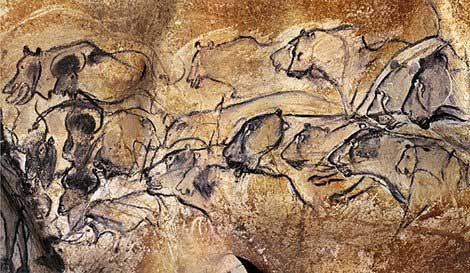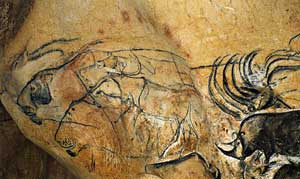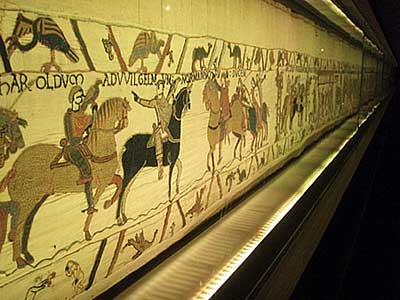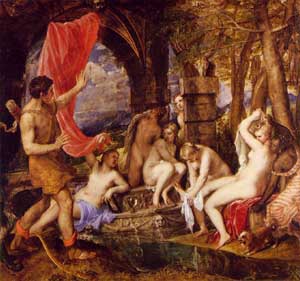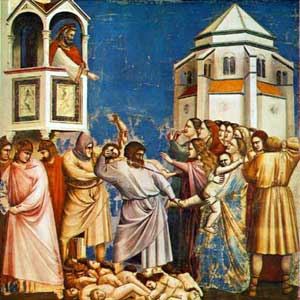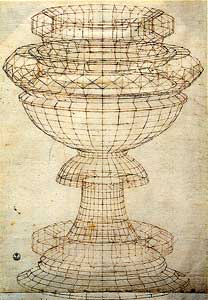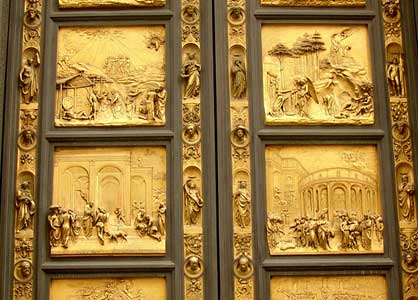|
|||
|
I. movement in early art |
|||
|
We tend to think that depicting stationary objects is the normal, default mode of drawing and painting, and that making them appear to move is a recent concept. But that could be a cultural bias. If you look back at the earliest surviving Western art in the caves of France and Spain 30,000 years ago, it looks like the concept of a moving image might be the default and that the frozen image evolved much later. These paintings of lions in Chauvet Cave are obviously an attempt to represent bodies moving through time as well as space. Look at them rushing toward the bison! And the horses, also at Chauvet— |
|||
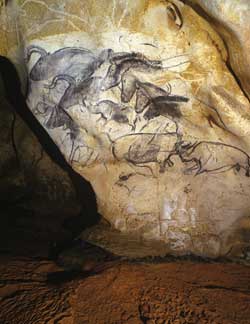 [Right] The reindeer in the upper left has 8 legs—and there are other examples of this in Chauvet– to give it the appearance of running. And the rhino seems to be charging ahead, while those below are standing still. (Note the deliberate use of negative space to clearly delineate the rhino and accentuate his dark mass and weight.) |
There's even a rudimentary kind of perspective in some of these paintings, showing that the artists were trying to portray not only linear time but 3-dimensional space as well. These images are from Werner Herzog’s movie, Cave of Forgotten Dreams. Some scholars think that that eyeball realism
couldn't have happened until there was a concept of a frozen
present, but that’s obviously wrong. These artists depicted
a moving present, very realistically.
|
||
That kind of motion depiction wouldn’t be achieved for another 20 or 30,000 years, but artists continued to represent time in their work. |
|||
 |
|||
|
This is drawn from an Egyptian burial chamber mural, about 4000 years old, showing wrestlers in action. The Middle Ages are full of this kind of thing.
One of the best examples is the Bayeux Tapestry (A.D. 1073) , a kind of graphic
novel telling the story of the Norman invasion of England by
William the Conqueror in 1066, only seven years before this was
made. It starts with King Harold II going on a voyage to visit
William in Normandy ...
|
|||
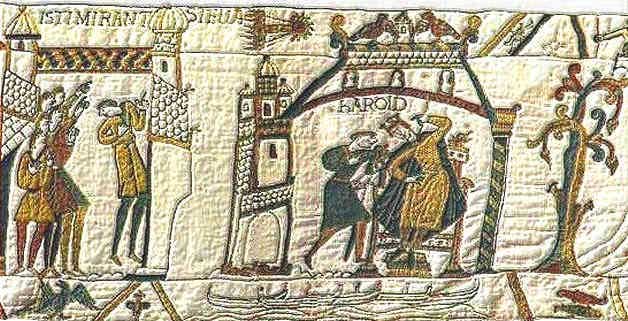 It's actually not a tapestry but an embroidery, stiched in wool on linen. Overhead you can see what we now know was Halley's Comet beside the Latin words ISTIMIRANT STELLA, "They are seeing the star." |
|||
|
II. “Freeze!” |
|||
|
But now we come to the end of that tradition and the discovery of the frozen present. it was Giotto, near the end of the 13th century, who stopped time, by depicting a single moment as seen from a single position in space. It took some 35,000 years to arrive at this concept.Leonard Shlain puts it like this: “Besides infusing Euclidean space back into art, Giotto also redefined the artist’s framework of time. He treated each instant of visual experience like a fluttering butterfly that he captured and pinned to his canvas. From Giotto until the modern era, this convention became the standard with each painting representing only one frozen instant viewed as if on a lighted, three-dimensional stage. Gone were the simultaneous representations of different temporal events in one work of art. This device, evident in the Bayeux Tapestry (A.D. 1073), among others, all but disappeared from Renaissance art. Not only did Giotto single-handedly create a new way to envision and organize space, he also isolated for art the frame of stopped time.” ( Leonard Shlain, Art & Physics, 1991, p.51) |
|||
There were some exceptions to this after Giotto, expressing maybe a suppressed urge to escape from the prison of the present. My favorite example of is Titian’s Diana and Actaeon, finished in 1559. In the foreground is the unfortunate hunter who has blundered into the goddess’s outdoor bathroom, the moment just before she turns him into a stag and sets his own dogs on him. But in the distance you can see what follows—Diana chasing a stag. |
|
||
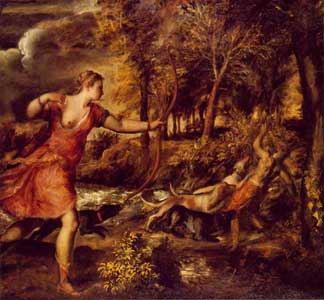 Titian, Death of Acteon, 1562, oil on canvas Titian painted this later– an enlargement of the killing scene glimpsed in the background of the other painting. |
|
I painted my own version of this back in 1991, and it looks like I was already violating Giotto's principle. The Pool shows Acteon (me) as a young man peeking into a Palm Beach solarium in the left background, as an older voyueristic artist in the center, hovering over Diana in the pool, while in the right background her hounds are chewing on his (my) bones. But it was Giotto who began the tradition of the “perfect moment” in Western art and everybody mostly stuck to it. |
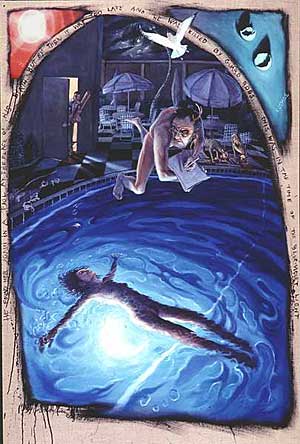 The Pool, 1991, oil on linen, 72 x 48 inches |
|
It led to the discovery of linear perspective. Because if you’re viewing the scene from one stationary location, at one frozen moment, you begin to notice how things look from that single point of view. The God’s-eye view has become the view of one of the eyes of one single individual—you. As long as you stand still and look straight ahead. We’ll see in a few minutes how time can distort perspective. This is also the time when the artist acquires an identity. Anonymity was a deliberate expression of humility, giving all the creative credit to God. The Renaissance saw the beginnings of the autonomous individual that in a few hundred years would characterize the Baroque. In music the unison choir of Medieval chant becomes the polyphonic dialog of the Renaissance, followed by the monody of the Baroque: the many voices of the madrigal became the single voice of opera. So the focus of our Western civilization was narrowing from the panorama of the church to the vanishing point of the individual. |
| Ghiberti learned
linear perspective from Alhazen’s (al-Hasan Ibn al-Haytham,
d. ca. 1041 AD) Book of Optics, written about 1021 A.D.
in Cairo but not translated into Italian until the 14th century.
This is Ghiberti’s Gates of Paradise—which must have
inspired Rodin's Gates of Hell. Notice the architectural
perspective. Brunelleschi was the first to use it in painting, around 1425, Alberti wrote a treatise on it, Uccello obsessed over it, and it went unchallenged for over 500 years.
|
But it wasn’t Picasso, Duchamp and the Italian Futurists who first unpinned Giotto’s butterfly from the canvas. . . . |
|
|
All pages on this Web site Copyright © 2004-2016 by Warren Criswell |
||
